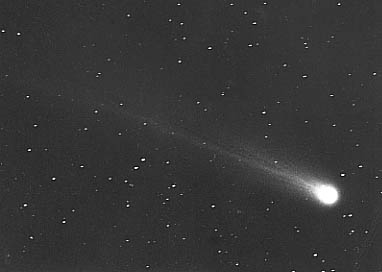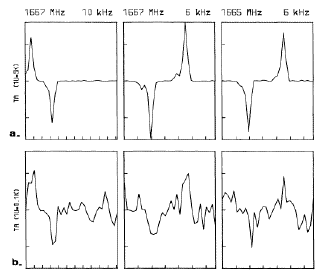
Radio observations of comets began early, as soon as efficient radio telescopes were available in the fifties. "Great comets" C/1956 R1 Arend-Roland and C/1965 S1 Ikeya-Seki were among the first targets of radio observations. First began a succession of inconsistent results, due to the idiosyncrasy of these objects. Indeed, comets are transient bodies, and little time is available to confirm results.
The comet that Lubos Kohoutek discovered on 7 Mars 1973 (C/1973 E1
Kohoutek according to the present designation, 1973 XII according to
the "old style" designation, or 1973 according to its provisional
designation) was promising to be a dramatic sight when close to the
Sun at the end of December of the same year. (It did not brighten as
expected, however, and was definitely not "the comet of the century",
but this is another story...). The early discovery of this unexpected
comet, ten months before perihelion, left some time for the
organization of observations. That year, Skylab, a manned orbital
station, was operated by NASA. This was a good opportunity for space
observations of a comet, the first in their kind. The schedule of
mission "Skylab 3" was modified to coincided with the period of
maximum brightness of the comet, in December-January. To support this
project, NASA advocated an international campaign of observation of
the comet with all available instrument and an information net was set
up.

A group of the Radio Department at Meudon Observatory (François Biraud, Gabriel Bourgois, Jacques Crovisier, René Fillit, Éric Gérard and Ilya Kazès) decided to join this campaign by attempting to observe this comet with the Nançay radio telescope. At that time, there were no confirmed radio detection of comets which could guide us. Among possibilities offered by the instrument, it was decided to search for continuum radiation (emitted by warm or ionized bodies) and for the 18 cm lines of OH (observed in interstellar clouds and circumstellar masers).
The search for continuum was negative. However, the OH lines were
detected at the beginning of December after only a few days of
observation. To our surprise, they were observed in absorption. These
results were rapidly reported in a Circular of the International
Astronomical Union. This was the first sound detection of a comet at
radio wavelengths. How the OH signal could be emitted was still to be
understood in order to ensure the scientific return of this
discovery.

 The OH lines observed in comet Kohoutek in December 1973 at the
Nançay radio telescope (from Biraud et al., 1974,
Astron. Astrophys. 34, 163). The upper panels show, for
comparison, the OH lines observed in absorption in the galactic source
W12. The lower panels show the same lines in the comet (average of
observations from 1 to 12 December). Observations were made using
frequency shifting, so that the signal appears as positive and
negative peaks.
The OH lines observed in comet Kohoutek in December 1973 at the
Nançay radio telescope (from Biraud et al., 1974,
Astron. Astrophys. 34, 163). The upper panels show, for
comparison, the OH lines observed in absorption in the galactic source
W12. The lower panels show the same lines in the comet (average of
observations from 1 to 12 December). Observations were made using
frequency shifting, so that the signal appears as positive and
negative peaks.